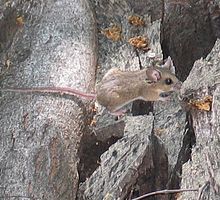Peromyscus boylii
| Brush mouse | |
|---|---|
 |
|
| Scientific classification | |
| Kingdom: | Animalia |
| Phylum: | Chordata |
| Class: | Mammalia |
| Order: | Rodentia |
| Family: | Cricetidae |
| Genus: | Peromyscus |
| Species: | P. boylii |
| Binomial name | |
|
Peromyscus boylii (Baird, 1855) |
|
| Subspecies | |
|
P. b. boylii |
|
P. b. boylii
P. b. glasselli
P. b. rowleyi
P. b. utahensis
The brush mouse (Peromyscus boylii) is a species of rodents in the family Cricetidae. It is found in mountainous areas of Mexico and the western United States at altitudes over 2,000 m (6,600 ft).
The brush mouse is medium-sized, with small ears and a long tail. It has yellowish-brown fur on the body, with slate grey under parts. The tail has only sparse hair for most of its length, but with a distinct brush-like tuft of hair at the tip (although the common name is, perhaps, more likely to come from brushy environment in which it lives). It has a head-body length of 86 to 105 mm (3.4 to 4.1 in) with a tail 88 to 115 mm (3.5 to 4.5 in) long. It is very similar in appearance to a number of closely related species of mouse living in the same area, although it can be distinguished from them by such features as the length of its tail, the size of its ears, and the presence of the tuft on the end of the tail.
The brush mouse can be found from northern California to eastern Colorado and western Texas, and south to Baja California and southern Mexico. Fossils of brush mice up to 35,000 years old have been discovered, but none have been definitively identified from outside the current range of the species.
Vegetation in brush mouse habitats may vary from location to location, but brush mice are consistently captured in areas with medium to high densities of shrubs and tree cover under 16 ft (4.9 m) in height. In California, mature chaparral (cover ≥50%) appears to provide more suitable habitat for brush mice than young, open chaparral (cover <50%). Similarly, in Arizona, Duran captured brush mice most frequently in shrub live oak and birchleaf mountain-mahogany (Cercocarpus betuloides) understory habitats with 45% to 50% plant cover. Fewer brush mice were captured in habitats with less plant cover. Holbrook observed that after vegetation crowns were removed in a manzanita (Arctostaphylos spp.)-oak shrubland, brush mice avoided the newly opened space. In another study, brush mice were strongly restricted to habitats in which gaps between rocks or ceanothus (Ceanothus spp.) on the site were less than 4 ft (1.2 m).
In addition to shrub density, the height of cover appears to influence brush mouse distribution within a site. An average understory height of 5.0–6.5 feet (1.5–2.0 metres) was preferred by brush mice over lower understory cover. In another study, brush mouse presence was positively correlated with microhabitats of shrub cover up to 10 feet (3.0 m) tall, logs over 3 inches (7.6 cm) in diameter, and understory trees 10–33 feet (3.0–10.1 metres) in height, but negatively correlated with grass-forb microhabitats.
...
Wikipedia

